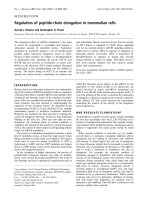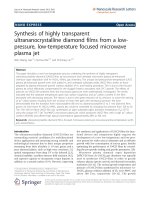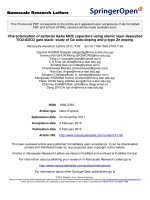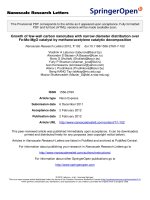Báo cáo toán học: " Existence of solutions of a new system of generalized variational inequalities in Banach spaces" ppt
Bạn đang xem bản rút gọn của tài liệu. Xem và tải ngay bản đầy đủ của tài liệu tại đây (259.68 KB, 21 trang )
This Provisional PDF corresponds to the article as it appeared upon acceptance. Fully formatted
PDF and full text (HTML) versions will be made available soon.
Existence of solutions of a new system of generalized variational inequalities in
Banach spaces
Journal of Inequalities and Applications 2012, 2012:8 doi:10.1186/1029-242X-2012-8
Somyot Plubtieng ()
Tippawan Thammathiwat ()
ISSN 1029-242X
Article type Research
Submission date 30 July 2011
Acceptance date 16 January 2012
Publication date 16 January 2012
Article URL />This peer-reviewed article was published immediately upon acceptance. It can be downloaded,
printed and distributed freely for any purposes (see copyright notice below).
For information about publishing your research in Journal of Inequalities and Applications go to
/>For information about other SpringerOpen publications go to
Journal of Inequalities and
Applications
© 2012 Plubtieng and Thammathiwat ; licensee Springer.
This is an open access article distributed under the terms of the Creative Commons Attribution License ( />which permits unrestricted use, distribution, and reproduction in any medium, provided the original work is properly cited.
Existence of solutions of a new system of gener-
alized variational inequalities in Banach spaces
Somyot Plubtieng
∗
and Tipphawan Thammathiwat
Department of Mathematics, Faculty of Science, Naresuan University, Phitsanulok 65000, Thailand.
∗
Corresp onding author:
Email addresses:
SP:
TT:
Abstract
In this article, we consider the solutions of the system of generalized variational inequality
problems in Banach spaces. By employing the generalized projection operator, the well-known
1
Fan’s KKM theorem and Kakutani-Fan-Glicksberg fixed point theorem, we establish some new
existence theorems of solutions for two classes of generalized set-valued variational inequalities
in reflexive Banach spaces under some suitable conditions.
Keywords: system of generalized variational inequalities; generalized projection; reflexive
Banach spaces.
AMS Subject classification: 47H04; 47H99; 47J20; 47J40.
1 Introduction
Let E be a Banach space, E
∗
be the dual space of E, and let ·, · denotes the duality
pairing of E
∗
and E. If E is a Hilbert space and K is a nonempty, closed and convex
subset of E, then it is well known that the metric projection operator P
K
: E −→ K plays
an important role in nonlinear functional analysis, optimization theory, fixed point theory,
nonlinear programming, game theory, variational inequality problem, and complementarity
problems, etc. (see example, [1–32] and the references therein.)
Let K be a nonempty, closed and convex subset of a Hilbert space H and let
A : K −→ H be a mapping. The classical variational inequality problem, denoted by
V IP (A, K), is to find x
∗
∈ K such that
Ax
∗
, z − x
∗
≥ 0
for all z ∈ K. The variational inequality has emerged as a fascinating and interesting
branch of mathematical and engineering sciences with a wide range of applications in
industry, finance, economics, social, ecology, regional, pure, and applied sciences; see,
e.g., [3, 10, 11, 17, 21–24, 29] and the references therein. Related to the variational
inequalities, we have the problem of finding the fixed p oints of the nonexpansive mappings,
2
which is the current interest in functional analysis. It is natural to consider the unified
approach to these different problems; see e.g. [17, 20, 22].
The system of variational inequality problems are the model of several equilibrium
problems, namely, traffic equilibrium problem, the spatial equilibrium problem, the Nash
equilibrium, the general equilibrium programming problem, etc. For further detail
see [2, 6, 12, 13, 18, 33] and the references therein. In [6, 18], some solution methods are
proposed. However, the existence of a solution of system of variational inequalities is
studied in [2, 6, 12, 13, 33].
On the other hand, Verma [23–26] introduced and studied a two step model for some
systems of variational inequalities which were difference from the sense of Pang [18] and
developed some iterative algorithms for approximating the solutions of these systems in
Hilbert spaces base on the convergence analysis of a two step projection method. In 2011,
Yao et al. [30] extended the main results of Verma [26] from the Hilbert spaces to the
Banach spaces.
In 1994, Alber [34] introduced the generalized projection π
K
: E
∗
−→ K and
Π
K
: E −→ K from Hilbert spaces to uniformly convex and uniformly smo oth Banach
spaces and studied their in detail. In [35], Alber presented some applications of the
generalized projections to approximately solve variational inequalities (1.1) and von
Neumann intersection problem in Banach spaces. Let A : K −→ E
∗
be a mapping and let
us find x
∗
∈ K such that
Ax
∗
− ξ, z − x
∗
≥ 0, ∀z ∈ K, (1.1)
where ξ ∈ E
∗
.
Recently, Li [16] extended the generalized projection operator π
K
: E
∗
−→ K from
uniformly convex and uniformly smooth Banach spaces to reflexive Banach spaces and
studied some properties of generalized projection operator with applications to solve the
variational inequality (1.1) in Banach spaces. Very recently, the generalized variational
inequality problem (GVIP(A,K)) has been studied by many authors (for example,
see [19, 28, 36, 37]). It is the problem to find x
∗
∈ K such that there exists u
∗
∈ Ax
∗
satisfying
u
∗
, z − x
∗
≥ 0, ∀z ∈ K. (1.2)
3
where A : K −→ 2
E
∗
is a multivalued mapping with nonempty values and 2
E
∗
denotes the
family of all subset of E
∗
.
In 2009, Wong et al. [27] studied the generalized variational inequality problems
defined by a multivalued mapping T , a nonempty closed convex subset K of a Banach
space E and b ∈ E
∗
is to find ¯x ∈ K such that there exists ¯u ∈ T (¯x) satisfying
¯u − b, y − ¯x ≤ 0, for all y ∈ K,
in reflexive and smooth Banach spaces by using generalized projection operator, Fan’s
KKM theorem and minimax theorem.
In this article, we consider the problem for finding the solution of the system of
generalized variational inequality problem (1.3) in the sense of Verma [23]. Let K be a
nonempty, closed and convex subset of E and A, B : K −→ 2
E
∗
be two multivalued
mappings with nonempty values, where 2
E
∗
denotes the family of all subset of E
∗
. The
system of generalized variational inequality problem (SGVIP(A,B,K)) is to find
(x
∗
, y
∗
) ∈ K × K such that there exist u
∗
∈ Ay
∗
, v
∗
∈ Bx
∗
satisfying
u
∗
, z − x
∗
≥ 0, ∀z ∈ K,
v
∗
, z − y
∗
≥ 0, ∀z ∈ K.
(1.3)
If A and B are single-valued, then the system of generalized variational inequality
problem is reduced to find (x
∗
, y
∗
) ∈ K × K such that
Ay
∗
, z − x
∗
≥ 0, ∀z ∈ K,
Bx
∗
, z − y
∗
≥ 0, ∀z ∈ K,
(1.4)
which is called a system of variational inequality problem (SVIP(A,B,K)).
Remark 1.1. (i) x
∗
∈ GV IP (A, K) if and only if (x
∗
, x
∗
) ∈ SGV IP(A, A, K).
(ii) x
∗
∈ V IP (A, K) if and only if (x
∗
, x
∗
) ∈ SV IP(A, A, K).
The purpose of this article is to establish some existence results of solutions for the
system variational inequalities (1.3) in reflexive Banach spaces by employing the properties
of the generalized projection operator, the well-known Fan’s KKM theorem and
Kakutani-Fan-Glicksberg theorem.
4
2 Preliminaries
Let E be a real Banach space and let S = {x ∈ E : x = 1} be the unit sphere of E.
A Banach space E is said to be strictly convex if for any x, y ∈ S,
x = y implies
x + y
2
< 1. (2.1)
It is also said to be uniformly convex if for each ε ∈ (0, 2], there exists δ > 0 such that for
any x, y ∈ S,
x − y ≥ ε implies
x + y
2
< 1 − δ. (2.2)
It is known that a uniformly convex Banach space is reflexive and strictly convex; and we
define a function δ : [0, 2] −→ [0, 1] called the modulus of convexity of E as follows:
δ(ε) = inf
1 −
x + y
2
: x, y ∈ E, x = y = 1, x − y ≥ ε
. (2.3)
Then E is uniformly convex if and only if δ(ε) > 0 for all ε ∈ (0, 2].
A Banach space E is said to be locally uniformly convex if for each ε > 0 and x ∈ S,
there exists δ(ε, x) > 0 for y ∈ S,
x − y ≥ ε implies
x + y
2
< 1 − δ(ε, x) (2.4)
From the above definition, it is easy to see that the following implications are valid:
E is uniformly convex ⇒ E is locally uniformly convex ⇒ E is strictly convex
A Banach space E is said to be smooth if the limit
lim
t−→0
x + ty − x
t
(2.5)
exists for all x, y ∈ S. It is also said to be uniformly smooth if the limit (2.5) is attained
uniformly for x, y ∈ S. We recall that E is uniformly convex if and only if E
∗
is uniformly
smooth. It is well known that E is smooth if and only if E
∗
is strictly convex. The
mapping J : E −→ E
∗
defined by
J(x) =
x
∗
∈ E : x
∗
, x = x
2
= x
∗
2
, for all x ∈ E,
is called the duality mapping of E. It is known that J(x) = ∂
1
2
x
2
, where ∂φ(x)
denotes the subdifferential of φ at x. The following properties of duality mapping J which
are useful for the rest of this work.
5
Proposition 2.1. [38] Let E be a reflexive Banach space and E
∗
be strictly convex.
(i) The duality mapping J : E −→ E
∗
is single-valued, surjective and bounded.
(ii) If E and E
∗
are locally uniformly convex, then J is a homeomorphism, that is, J and
J
−1
are continuous single-valued mappings.
Next, we consider the functional V : E
∗
× E −→ R defined as
V (ϕ, x) = ϕ
2
− 2ϕ, x + x
2
, forall ϕ ∈ E
∗
, and x ∈ E.
It is clear that V (ϕ, x) is continuous and the map x → V (ϕ, x) and ϕ → V (ϕ, x) are
convex and (ϕ − x)
2
≤ V (ϕ, x) ≤ (ϕ + x)
2
. We remark that the main Lyapunov
functional V was first introduced by Alber [35] and its properties were studied there. By
using this functional, Alber defined a generalized projection operator on uniformly convex
and uniformly smooth Banach spaces which was further extended by Li [16] on reflexive
Banach spaces.
Definition 2.2. [16] Let E be reflexive Banach space with its dual E
∗
and K be a
nonempty, closed and convex subset of E. The operator π
K
: E
∗
−→ K defined by
π
K
(ϕ) = {x ∈ K : V (ϕ, x) = inf
y∈K
V (ϕ, y)}, for all ϕ ∈ E
∗
, (2.6)
is said to b e a generalized projection operator. For each ϕ ∈ E
∗
, the set π
K
(ϕ) is called the
generalized projection of ϕ on K.
We mention the following useful properties of the operator π
K
(ϕ).
Lemma 2.3. [16] Let E be a reflexive Banach space with its dual E
∗
and K be a
nonempty closed convex subset of E, then the following properties hold:
(i) The operator π
K
: E
∗
−→ 2
K
is single-valued if and only if E is strictly convex.
6
(ii) If E is smooth, then for any given ϕ ∈ E
∗
, x ∈ π
K
ϕ if and only if
ϕ − J(x), x − y ≥ 0, ∀y ∈ K.
(iii) If E is strictly convex, then the generalized projection operator π
K
: E
∗
−→ K is
continuous.
Lemma 2.4. [5] In every reflexive Banach space, an equivalent norm can be introduced so
that E and E
∗
are locally uniformly convex and thus also strictly convex with respect to the
new norm on E and E
∗
.
From Lemma 2.4, we can assume for the rest of this work that the norm || · || of the
reflexive Banach space E is such that E and E
∗
are locally uniformly convex. In this case,
we note that the generalized metric projection operator π
K
and the duality mapping J are
single-valued and continuous.
Lemma 2.5. [38] Let A and B be convex subsets of some real topological vector space with
B is compact and let p : A × B −→ R. If p(·, b) is lower semicontinuous and quasiconvex on
A for all b ∈ B and p(a, ·) is upper semicontinuous and quasiconcave on B for all a ∈ A,
then
inf
a∈A
max
b∈B
p(a, b) = max
b∈B
inf
a∈A
p(a, b).
Definition 2.6 (KKM mapping). Let K be a nonempty subset of a linear space E. A
set-valued mapping G : K −→ 2
E
is said to be a KKM mapping if for any finite subset
{y
1
, y
2
, . . . , y
n
} of K, we have
co{y
1
, y
2
, . . . , y
n
} ⊆ ∪
n
i=1
G(y
i
)
where co{y
1
, y
2
, . . . , y
n
} denotes the convex hull of {y
1
, y
2
, . . . , y
n
}.
7
Lemma 2.7 (FanKKM Theorem). Let K be a nonempty convex subset of a Hausdorff
topological vector space E and let G : K −→ 2
E
be a KKM mapping with closed values. If
there exists a point y
0
∈ K such that G(y
0
) is a compact subset of K, then ∩
y∈K
G(y) = ∅.
Lemma 2.8. [9] Let K be a nonempty compact subset of a locally convex Hausdorff vector
topology space E. If S : K −→ 2
K
is upper semicontinuous and for any x ∈ K, S(x) is
nonempty, convex and closed, then there exists an x
∗
∈ K such that x
∗
∈ S(x
∗
).
Lemma 2.9. [39] Let X and Y be two Hausdorff topological vector spaces and
T : X −→ 2
Y
be a set-valued mapping. Then the following properties hold:
(i) If T is closed and T (X) is compact, then T is upper semicontinuous, where
T (X) = ∪
x∈X
T (x) and T (X) denotes the closure of the set T (X).
(ii) If T is upper semicontinuous and for any x ∈ X, T(x) is closed, then T is closed.
(iii) T is lower semicontinuous at x ∈ X if and only if for any y ∈ T (x) and any net
{x
α
}, x
α
−→ x, there exists a net {y
α
} such that y
α
∈ T (x
α
) and y
α
−→ y.
3 Main result
Proposition 3.1. Let E be a reflexive and smooth Banach space and let K be a closed
convex subset of E. Assume that α, β > 0 and A : K −→ 2
E
∗
, B : K −→ 2
E
∗
are two
multivalued mappings with nonempty values. Then (x
∗
, y
∗
) is a solution of (1.3) if and only
8
if there exist u
∗
∈ Ay
∗
, v
∗
∈ Bx
∗
such that
x
∗
= π
K
[J(x
∗
) − αu
∗
],
y
∗
= π
K
[J(y
∗
) − βv
∗
].
(3.1)
Proof. It follows from the definition of SGVIP(A,B,K) and Lemma 2.3, that
(x
∗
, y
∗
) is a solution of (1.3) ⇔ ∃u
∗
∈ Ay
∗
, v
∗
∈ Bx
∗
such that
u
∗
, z − x
∗
≥ 0, ∀z ∈ K,
v
∗
, z − y
∗
≥ 0, ∀z ∈ K.
⇔
αu
∗
, z − x
∗
≥ 0, ∀z ∈ K,
βv
∗
, z − y
∗
≥ 0, ∀z ∈ K.
⇔
J(x
∗
) − αu
∗
− J(x
∗
), x
∗
− z ≥ 0, ∀z ∈ K,
J(y
∗
) − βv
∗
− J(y
∗
), y
∗
− z ≥ 0, ∀z ∈ K.
⇔
x
∗
= π
K
[J(x
∗
) − αu
∗
],
y
∗
= π
K
[J(y
∗
) − βv
∗
].
Theorem 3.2. Let E be a reflexive and smooth Banach space such that E and E
∗
are
locally uniformly convex. Let K be a compact convex subset of E. Let A : K −→ 2
E
∗
and
B : K −→ 2
E
∗
be two upper semicontinuous multivalued mappings with nonempty values
such that A(x) and B(x) are weak
∗
compact and convex for each x ∈ K. Then the problem
(1.3) has a solution and the set of solutions (1.3) is closed.
9
Proof. Step 1. Let α, β > 0 and fixed x ∈ K, for each z ∈ K, the sets G
x
(z) and H
x
(z)
define as follow
G
x
(z) := {y ∈ K : inf
u∈Ax
(J(y) − αu, 2(z − y) + y
2
) ≤ z
2
} ,
H
x
(z) := {y ∈ K : inf
v∈Bx
(J(y) − βv, 2(z − y) + y
2
) ≤ z
2
} .
(3.2)
(a1) For each z ∈ K, we have z ∈ G
x
(z) and z ∈ H
x
(z). Hence G
x
(z) and H
x
(z) are
nonempty subsets of K.
(a2) For any finite set {z
1
, z
2
, . . . , z
n
} ⊂ K we claim that co{z
1
, z
2
, . . . , z
n
} ⊂ ∪
n
j=1
G
x
(z
j
)
and co{z
1
, z
2
, . . . , z
n
} ⊂ ∪
n
j=1
H
x
(z
j
).
Let z ∈ co{z
1
, z
2
, . . . , z
n
}. Then z =
n
j=1
λ
j
z
j
where λ
j
∈ [0, 1] and
n
j=1
λ
j
= 1. We
observe that
n
j=1
inf
u∈Ax
J(z) − αu, 2λ
j
(z
j
− z) ≤ inf
u∈Ax
J(z) − αu, 2
n
j=1
λ
j
(z
j
− z) = 0.
Thus,
n
j=1
inf
u∈Ax
J(z) − αu, 2λ
j
(z
j
− z) + λ
j
z
2
≤ z
2
≤
n
j=1
λ
j
z
j
2
.
This implies that
n
j=1
inf
u∈Ax
J(z) − αu, 2λ
j
(z
j
− z) + λ
j
z
2
− λ
j
z
j
2
≤ 0.
So there exists j > 0 such that
inf
u∈Ax
J(z) − αu, 2λ
j
(z
j
− z) + λ
j
z
2
− λ
j
z
j
2
≤ 0.
Hence,
inf
u∈Ax
J(z) − αu, 2(z
j
− z) + z
2
≤ z
j
2
.
10
Therefore z ∈ G
x
(z
j
) ⊂ ∪
n
j=1
G
x
(z
j
). Similarly, we obtain that there exists k > 0 such that
z ∈ H
x
(z
k
) ⊂ ∪
n
j=1
H
x
(z
j
). Hence we have the claim. This implies that G
x
(·) and H
x
(·) are
KKM-mappings.
Step 2. Show that G
x
(z) and H
x
(z) are closed for all z ∈ K.
Let {x
n
} be a sequence in G
x
(z) such that x
n
−→ x
0
in a norm topology. Then there exists
u
n
∈ Ax such that
J(x
n
) − αu
n
, 2(z − x
n
) + x
n
2
= inf
u∈Ax
J(x
n
) − αu, 2(z − x
n
) + x
n
2
≤ z
2
. (3.3)
Since A(x) is compact, there exists a subsequence {u
n
j
} of {u
n
} such that
u
n
j
−→ u
0
∈ A(x). Thus without loss of generality, we may assume that u
n
−→ u
0
and
observe that
J(x
n
) − αu
n
, 2(z − x
n
) + x
n
2
−→ J(x
0
) − αu
0
, 2(z − x
0
) + x
0
2
. (3.4)
Therefore
inf
u∈Ax
J(x
0
) − αu, 2(z − x
0
) + x
0
2
) ≤ J(x
0
) − αu
0
, 2(z − x
0
) + x
0
2
≤ z
2
. (3.5)
This implies that x
0
∈ G
x
(z) and so G
x
(z) is closed for all z ∈ K. Similarly, we obtain that
H
x
(z) is closed for all z ∈ K. Then ∩
z∈K
G
y
(z) and ∩
z∈K
H
x
(z) are also closed.
Step 3. Show that ∩
z∈K
G
x
(z) = ∅ = ∩
z∈K
H
x
(z).
Since G
x
(z) and H
x
(z) are closed subsets of K and K is compact, G
x
(z) and H
x
(z) are
compact subsets of K. It follows from Steps 1, 2, and Lemma 2.7 that
∩
z∈K
G
x
(z) = ∅ = ∩
z∈K
H
x
(z).
11
Step 4. Show that the problem (1.3) has a solution.
For any x, y ∈ K, we may choose ¯x ∈ ∩
z∈K
G
y
(z) and ¯y ∈ ∩
z∈K
H
x
(z) by Step 3. We define
the set-valued mapping S : K × K −→ 2
K×K
by
S(x, y) = ({¯x}, {¯y}) where ¯x ∈ ∩
z∈K
G
y
(z) and ¯y ∈ ∩
z∈K
H
x
(z), ∀(x, y) ∈ K × K. (3.6)
By Definition of S(x, y) and Step 3, we obtain that S(x, y) is a nonempty closed convex
subset of K × K for all (x, y) ∈ K × K. Since ∩
z∈K
G
y
(z), ∩
z∈K
H
x
(z) ⊂ K and K is
compact, ∩
z∈K
G
y
(z) and ∩
z∈K
H
x
(z) are compact. We only show that S is a closed
mapping. Indeed, let {(x
n
, y
n
)} be a net in K × K such that (x
n
, y
n
) −→ (x
0
, y
0
) in the
norm topology and let (u
n
, v
n
) ∈ S(x
n
, y
n
) such that (u
n
, v
n
) −→ (u
0
, v
0
). By definition of a
mapping S, we have (u
n
, v
n
) ∈ ({¯x
n
}, {¯y
n
}) where ¯x
n
∈ ∩
z∈K
G
y
n
(z) and ¯y
n
∈ ∩
z∈K
H
x
n
(z).
That is for each z ∈ K, u
n
= ¯x
n
∈ G
y
n
(z) and v
n
= ¯y
n
∈ H
x
n
(z). It follows from (3.2) that
there exist a
n
∈ Ay
n
and b
n
∈ Bx
n
such that
J(u
n
) − αa
n
, 2(z − u
n
) + u
n
2
= inf
u∈Ay
n
(J(u
n
) − αu, 2(z − u
n
) + u
n
2
) ≤ z
2
,
J(v
n
) − βb
n
, 2(z − v
n
) + v
n
2
= inf
v∈Bx
n
(J(v
n
) − βv, 2(z − v
n
) + v
n
2
) ≤ z
2
.
(3.7)
Now, we define two sets T
1
:= {x
1
, x
2
, . . . , x
n
, . . .} ∪ {x
0
} and
T
2
:= {y
1
, y
2
, . . . , y
n
, . . . } ∪ {y
0
}. It follows from our assumption that A(T
2
) and B(T
1
) are
compact. Thus there exist two subsequences {a
n
j
} of {a
n
} and {b
n
k
} of {b
n
} such that
a
n
j
−→ a
0
∈ A(T
2
) and b
n
k
−→ b
0
∈ B(T
2
). Since A and B are upper semicontinuous,
12
a
0
∈ Ay
0
and b
0
∈ Bx
0
. Taking j, k −→ ∞ in (3.7), we obtain that
inf
u∈Ay
0
(J(u
0
) − αu, 2(z − u
0
) + u
0
2
) ≤ J(u
0
) − αa
0
, 2(z − u
0
) + u
0
2
≤ z
2
,
inf
v∈Bx
0
(J(v
0
) − βv, 2(z − v
0
) + v
0
2
) ≤ J(v
0
) − βb
0
, 2(z − v
0
) + v
0
2
≤ z
2
.
Hence u
0
∈ G
y
0
(z) and v
0
∈ H
x
0
(z) for all z ∈ K. This implies that
(u
0
, v
0
) ∈ ({u
0
}, {v
0
}) = S(x
0
, y
0
). Thus, S is a closed mapping. It follows from Lemma 2.9
that S is upper semicontinuous. By Lemma 2.8, there exists a point
(x
∗
, y
∗
) ∈ S(x
∗
, y
∗
) = ({¯x}, {¯y}) where ¯x ∈ ∩
z∈K
G
y
∗
(z) and ¯y ∈ ∩
z∈K
H
x
∗
(z). That is
x
∗
= ¯x ∈ G
y
∗
(z) and y
∗
= ¯y ∈ H
x
∗
(z) for all z ∈ K. By definition of G
y
∗
(z) and H
x
∗
(z), we
get
inf
u∈Ay
∗
(J(x
∗
) − αu, 2(z − x
∗
) + x
2
) ≤ z
2
, ∀z ∈ K,
inf
v∈Bx
∗
(J(y
∗
) − βv, 2(z − y
∗
) + y
∗
2
) ≤ z
2
, ∀z ∈ K.
(3.8)
This implies that
sup
z∈K
inf
u∈Ay
∗
(J(x
∗
) − αu, 2(z − x
∗
) + x
2
− z
2
) ≤ 0,
sup
z∈K
inf
v∈Bx
∗
(J(y
∗
) − βv, 2(z − y
∗
) + y
∗
2
− z
2
) ≤ 0.
(3.9)
Put
p
1
(u, z) = J(x
∗
) − αu, 2(z − x
∗
) + x
∗
2
− z
2
,
p
2
(v, z) = J(y
∗
) − βv, 2(z − y
∗
) + y
∗
2
− z
2
.
(3.10)
Then the functional p
1
(·, z), p
2
(·, z) are lower semicontinuous and convex. Also the function
13
p
1
(u, ·), p
2
(v, ·) are upper semicontinuous and concave. Apply minimax theorem, we have
sup
z∈K
inf
u∈Ay
∗
p
1
(u, z) = inf
u∈Ay
∗
sup
z∈K
p
1
(u, z) ≤ 0,
sup
z∈K
inf
v∈Bx
∗
p
2
(v, z) = inf
v∈Bx
∗
sup
z∈K
p
2
(v, z) ≤ 0.
(3.11)
Since the functionals
u
→
sup
z∈K
p
1
(
u, z
) and
v
→
sup
z∈K
p
2
(
v, z
) are lower semicontinuous
and A(y
∗
), B(x
∗
) are compact, there exist u
∗
∈ A(y
∗
) and v
∗
∈ B(x
∗
) such that
sup
z∈K
p
1
(u
∗
, z) = inf
u∈Ay
∗
sup
z∈K
p
1
(u, z) ≤ 0,
sup
z∈K
p
2
(v
∗
, z) = inf
v∈Bx
∗
sup
z∈K
p
2
(v, z) ≤ 0.
(3.12)
This implies that
p
1
(u
∗
, z) ≤ 0, ∀z ∈ K,
p
2
(v
∗
, z) ≤ 0, ∀z ∈ K.
(3.13)
That is
J(x
∗
) − αu
∗
, 2(z − x
∗
) + x
∗
2
− z
2
≤ 0, ∀z ∈ K,
J(y
∗
) − βv
∗
, 2(z − y
∗
) + y
∗
2
− z
2
≤ 0, ∀z ∈ K.
(3.14)
So, we obtain that
V (J(x
∗
) − αu
∗
, x
∗
) ≤ V (J(x
∗
) − αu
∗
, z), ∀z ∈ K,
V (J(y
∗
) − βv
∗
, y
∗
) ≤ V (J(y
∗
) − βv
∗
, z), ∀z ∈ K.
(3.15)
By definition of generalized projection operator, we get x
∗
= π
K
(J(x
∗
) − αu
∗
) and
y
∗
= π
K
(J(y
∗
) − βv
∗
). It follows from Proposition 3.1 that (x
∗
, y
∗
) is the solutions of
problem (1.3).
Step 5. Show that the set of solutions (1.3) is closed.
14
Put T := {(x, y) ∈ K × K : (x, y) is a solution of (1.3)}. Let {(x
n
, y
n
)} be a net in T such
that (x
n
, y
n
) −→ (x
0
, y
0
) in the norm topology. By definition (1.3) we obtain that there
exist u
n
∈ A(y
n
) and v
n
∈ B(x
n
) such that
u
n
, z − x
n
≥ 0, ∀z ∈ K,
v
n
, z − y
n
≥ 0, ∀z ∈ K.
(3.16)
We define two sets T
1
:= {x
1
, x
2
, . . . , x
n
, . . . } ∪ {x
0
} and T
2
:= {y
1
, y
2
, . . . , y
n
, . . . } ∪ {y
0
}.
It follows from our assumption that A(T
2
) and B(T
1
) are compact. Thus there exist two
subsequences {u
n
j
} of {u
n
} and {v
n
k
} of {v
n
} such that u
n
j
−→ u
0
∈ A(T
2
) and
v
n
k
−→ v
0
∈ B(T
2
). Since A and B are upper semicontinuous, u
0
∈ Ay
0
and v
0
∈ Bx
0
.
Taking j, k −→ ∞ in (3.16), we obtain that
u
0
, z − x
0
≥ 0, ∀z ∈ K,
v
0
, z − y
0
≥ 0, ∀z ∈ K.
(3.17)
Thus (x
0
, y
0
) ∈ T and so T is closed. This completes the proof.
If A and B are two single-valued mappings, then from Theorem 3.2, we derive the following
result.
Corollary 3.3. Let E be a reflexive and smooth Banach space such that E and E
∗
are
locally uniformly convex. Let K be a compact convex subset of E. Let A : K −→ E
∗
and
B : K −→ E
∗
be two continuous single-valued mappings. Then the problem (1.4) has a
solution and the set of solutions (1.4) is closed.
15
Acknowledgements
The authors would like to thanks The Thailand Research Fund for financial support.
Moreover, TT is also supported by the Royal Golden Jubilee Program under Grant
PHD/0117/2549, Thailand.
Competing interests
The authors declare that they have no competing interests.
Authors’ contributions
This work was carried out in collaboration between all authors. SP gave the ideas of the
problems in this research and interpreted the results. TT proved the theorems, interpreted
the results and wrote the article. All authors defined the research theme, read and
approved the manuscript.
References
1. Baiocchi, C, Capelo, A: Variational and Quasi-Variational Inequalietis, Application to Free
Boundary Problem. Wiley, New York/London (1984)
2. Bianchi, M: Pseudo P-monotone operators and variational inequalities. In: Report 6, Istituto
di econometria e Matematica per le decisioni economiche, Universita Cattolica del Sacro
Cuore, Milan, Italy 1993
3. Chang, SS, Joseph Lee, HW, Chan, CK: A new method for solving equilibrium problem fixed
point problem and variational inequality problem with application to optimization. Nonlinear
Anal. 70, 3307–3319 (2009)
16
4. Cho, YJ, Fang, YP, Huang, NJ, Hwang, HJ: Algorithms for systems of nonlinear variational
inequalities. J. Korean Math. Soc. 41, 489–499 (2004)
5. Cioranescu, I: Geometry of Banach Spaces Duality Mappings and Nonlinear Problem. Kluwer
Acadimic Publishers, Dordrecht (1990)
6. Cohen, G, Chaplais, F: Nested monotony for variational inequalities over a product of spaces
and convergence of iterative algorithms. J. Optim. Theory Appl. 59 360–390 (1988)
7. Fan, K: A generalization of Tychonoff’s fixed point theorem. Math. Ann. 142, 305–310 (1961)
8. Giannessi, F, Maugeri, A: Vairational Inequalities and Network Equilibrium Problems.
Plenum, New York (1995)
9. Holmes, RB: Geometric Functional Analysis and its Application. Springer, New York (1975)
10. Isac, G: Complementarity problems. In: Lecture Notes in Math., vol. 1528. Springer, Berlin
(1992)
11. Isac, G, Sehgal, VM, Singh, SP: An altenate version of a variational inequality. Indian J.
Math. 41, 25–31 (1999)
12. Kassay, G, Kolumb´an, J: System of multi-valued variational variational inequalities. Publ.
Math. Debrecen 54, 267–279 (1999)
13. Kassay, G, Kolumb´an, J, P´ales, Z: Factorization of Minty and Stampacchia variational
inequality system. European J. Oper. Res. 143, 377–389 (2002)
14. Kim, JK, Kim, DS: A new system of generalized nonlinear mixed variational inequalities in
Hilbert spaces. J. Convex Anal. 11, 235–243 (2004)
17
15. Li, JL: On the existence of solutions of variational inequalities in Banach space. J. Math.
Anal. Appl. 295, 115–126 (2004)
16. Li, JL: The generalized projection operator on reflexive Banach spaces and its application. J.
Math. Anal. Appl. 306, 55–71 (2005)
17. Nadezhkina, N, Takahashi, W: Weak convergence theorem by an extragradient method for
nonexpansive mappings and monotone mappings. J. Optim. Theory Appl. 128, 191–201
(2006)
18. Pang, JS: Asymmetric variational inequality problems over product sets: Applications and
iterative methods. Math. Program. 31, 206–219 (1985)
19. Shih, M-H, Tan, K-K: Browder–Hartman–Stempacchia variational inequalities for
multi-valued monotone operators. J. Math. Anal. Appl. 134, 431–440 (1988)
20. Suzuki, T: Strong convergence of krasnoselskii and mann’s type sequences for one-parameter
nonexpansive semigroups without bochner integrals. J. Math. Anal. Appl. 305, 227–239
(2005)
21. Takahashi, S, Takahashi, W: Viscosity approximation methods for equilibrium problems and
fixed point problems in Hilbert spaces. J. Math. Anal. Appl. 311(1), 506–515 (2007)
22. Takahashi, W, Toyoda, M: Weak convergence theorems for nonexpansive mappings and
monotone mappings. J. Optim. Theory Appl. 118, 417–428 (2003)
23. Verma, RU: On a new system of nonlinear variational inequalities and associated iterative
algorithms. Math. Sci. Res. Hot-Line 3(8), 65–68 (1999)
18
Yuan, GXZ: KKM Theory and Applications in Nonlinear Analysis. Marcel-Dekker, New York
24. Verma, RU: Iterative algorithms and a new system of nonlinear quasivariational inequalities.
Adv. Nonlinear Var. Inequal. 4(1), 117–124 (2001)
25. Verma, RU: Projection methods, algorithms, and a new system of nonlinear variational
inequalities. Comp. Math. Appl. 41, 1025–1031 (2001)
26. Verma, RU: General convergence analysis for two-step projection methods and application to
variational problems. Appl. Math. Lett. 18, 1286–1292 (2005)
27. Wong, M-M, Ansari, QH, Yao, J-C: Existence of solutions of generalized variational
inequalities in reflexive Banach spaces. Appl. Math. Lett. 22, 197–201 (2009)
28. Yao, JC: Muti-valued variational inequalities with K-psuedomonotone opeerators. J. Optim.
Theory Appl. 83(2), 391–403 (1994)
29. Yao, JC, Chadli, O: Pseudomonotone Complementarity Problems and variational
Inequalities. In: Crouzeix, JP, Haddjissas, N, Schaible, S (eds.) Handbook of Generalized
Convexity and Monotonicity, pp. 501–558. Springer, New York (2005)
30. Yao, Y, Liou, Y-C, Kang, SM: Two step projdection methods for a system of variational
inequality problems in Banach spaces. J. Glob. Optim. (2011). doi:10.1007/s10898-011-9804-0
31. Yao, Y, Shahzad, N: Strong convergence of a proximal point algorithm with general errors.
Optim. Lett. (2011). doi:10.1007/s11590-011-0286-2
32.
(1999)
19
33. Ansari, QH, Yao, JC: A fixed point theorem and its applications to a system of variational
inequalities. Bull. Aust. Math. Soc. 59, 433–442 (1999)
34. Alber, Ya: Generalized projection operators in Banach spaces: properties and application. In:
Proceedinng of the Israel Seminar, Ariel, Israel, Funct. Differential Equation vol. 1, pp. 1–21,
1994
35. Alber, Ya: Metric and Genernalized Projection Operators in Banach Space: Properties and
Application. In: Kartsatos, A (ed.) Theory and Applications of Nonlinear Operators of
Accretive and Monotone Type, pp. 15–50. Marcel Dekker, New York (1996)
36. Ansari, QH, Lin, YC, Yao, JC: General KKM theorem with applications to minimax and
variational inequalities. J. Optim. Theory Appl. 104(1), 41–57 (2000)
37. Zeng, LC, Yao, JC: Existence theorems for variational inequalities in Banach spaces. J.
Optim. Theory Appl. 132(2), 321–337 (2007)
38. Zeidler, E: Nonlinear Functional Analysis and Its Application, I Fixed-Point Theorems.
Springer, New York (1993)
39. Aubin, JP, Ekeland, I: Applied Nonlinear Analysis. Wiley, New York (1984)
20









